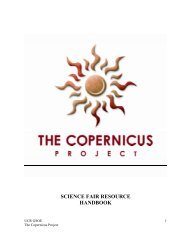Action Research Summary - Copernicus Project - University of ...
Action Research Summary - Copernicus Project - University of ...
Action Research Summary - Copernicus Project - University of ...
You also want an ePaper? Increase the reach of your titles
YUMPU automatically turns print PDFs into web optimized ePapers that Google loves.
Compiled and Written by Jocelyn Edey and Steve Gómez<br />
1<br />
<strong>Action</strong> <strong>Research</strong> <strong>Summary</strong><br />
<strong>Copernicus</strong> <strong>Project</strong><br />
SSI Year 4: K-6 Literacy through Science<br />
Use <strong>of</strong> Technology in the Classroom (5 studies)<br />
I. <strong>Research</strong> Question: If I incorporate technology into the 5E lesson approach, will<br />
students have a higher interest in learning?<br />
<strong>Summary</strong> <strong>of</strong> Results and Implications: Teacher researcher acknowledges limits <strong>of</strong> this<br />
particular study to answer the original research question. However, this study did find<br />
significant increases on two measures – 1) Student technology exposure and interest<br />
towards science instruction/technology infused instruction, and 2) Student technology<br />
exposure and interest towards science instruction: Traditional vs. Technology infused<br />
lesson.<br />
In general, this study found that incorporating technology into lesson plans may<br />
increase student interest and engagement. Teacher researcher argues that this can<br />
have positive influences on student performance throughout the year and would like to<br />
continue research to if effects are sustained over longer periods <strong>of</strong> time.<br />
II. <strong>Research</strong> Question: Does using technology (including Discovery Streaming’s webbased<br />
videos and clips, You Tube video clips, “Googled” pictures and diagrams,<br />
PowerPoint, etc.) help my second grade students understand the science concepts<br />
better, as evidenced by scores on quizzes or tests?<br />
<strong>Summary</strong> <strong>of</strong> Results and Implications: This study was conducted for practical purposes.<br />
The teacher researcher was curious about understanding just how effective technology<br />
is in helping students comprehend science material better. This study would help inform<br />
the teacher researcher as to how much technology and when to implement technology<br />
into a lesson so that it helped his students perform better.<br />
The data in this particular study did not support the researcher’s hypothesis that use <strong>of</strong><br />
technology would help bring student test scores up. The data collected showed no<br />
difference in total average scores between lessons that used some form <strong>of</strong> technology<br />
and lessons that didn’t. Teacher researcher attributes these results to the limits <strong>of</strong> his<br />
research design which made used <strong>of</strong> “pre-made “comprehension examinations provided<br />
by the textbook publisher Macmillan McGraw/Hill.<br />
III. <strong>Research</strong> Question: Will the utilization <strong>of</strong> technology during science instruction<br />
promote interest, improve confidence, and increase science test scores?<br />
<strong>Summary</strong> <strong>of</strong> Results and Implications: Teacher researcher conducted this study<br />
because <strong>of</strong> a lack <strong>of</strong> experience in integrating technology in the classroom. This study<br />
would help inform the teacher as to what effects technology can have on student<br />
The <strong>Copernicus</strong> <strong>Project</strong> is 100% funded by the<br />
United States Department <strong>of</strong> Education Office <strong>of</strong> Post-Secondary Education<br />
Teacher Quality Enhancement Grants Program<br />
Awarded to the<br />
<strong>University</strong> <strong>of</strong> California, Riverside<br />
Graduate School <strong>of</strong> Education
Compiled and Written by Jocelyn Edey and Steve Gómez<br />
2<br />
comprehension and performance and would help determine this teacher’s focus on<br />
updating her own technology skills.<br />
A quantitative pre/post test design was used to collect data. Surveys were administered<br />
to students before intervention and shortly after. Results were not conclusive and did<br />
not indicate a relationship between technology implementation and student<br />
performance. Teacher researcher attributes the results to poor evaluation tool and<br />
flawed research design.<br />
IV. <strong>Research</strong> Question: Will the use <strong>of</strong> technology improve supplemental assignment<br />
completion rates and sight word reading skills in kindergarten students?<br />
<strong>Summary</strong> <strong>of</strong> Results and Implications: The purpose <strong>of</strong> this study was to determine if<br />
adding technology support (Biffy 50 Toons DVD) for the students’ “Cookie Crunchers”<br />
assignment would improve 32 Kindergarten students’ ability to instantly recognize sight<br />
words for continued reading success.<br />
A pre/post test quantitative research design was used to collect the data. Teacher<br />
researcher acknowledges lack <strong>of</strong> control for external variables, such as student English<br />
pr<strong>of</strong>iciency. Nevertheless, this study demonstrated positive results after implementing a<br />
technology-based intervention on teaching the students sight words. In comparing the<br />
pre-test and post-test results, there was a sharp rise in student achievement after the<br />
implementation <strong>of</strong> technology. Teacher researcher found that using the Biffy 50 Toons<br />
DVD, students became actively engaged in learning sight words without help from their<br />
parents. Teacher concludes that the use <strong>of</strong> technology improved supplemental<br />
assignment completion rates in Kindergarten students in this classroom.<br />
V. <strong>Research</strong> Question: Do my first graders test scores, thereby their achievement,<br />
increase in science with the use <strong>of</strong> technology?<br />
<strong>Summary</strong> <strong>of</strong> Results and Implications: Teacher researcher divided students into two<br />
separate groups to conduct this research. One group was designated the ‘control’ group<br />
the other received an intervention consisting <strong>of</strong> increased use <strong>of</strong> technology<br />
(PowerPoint). Data was collected from 19 students in a first grade classroom.<br />
Teacher researcher found significant differences in the performance <strong>of</strong> both sets <strong>of</strong><br />
students. On average, students in this study scored 10% higher in the treatment group<br />
versus control group leading researcher to conclude that indeed technology had an<br />
effect on the students’ performance. Even when the data were broken up by gender, the<br />
researcher found the 10% increase to remain true even by gender (both girls and boys<br />
in the intervention group scored better than their counterparts in the control group).<br />
The <strong>Copernicus</strong> <strong>Project</strong> is 100% funded by the<br />
United States Department <strong>of</strong> Education Office <strong>of</strong> Post-Secondary Education<br />
Teacher Quality Enhancement Grants Program<br />
Awarded to the<br />
<strong>University</strong> <strong>of</strong> California, Riverside<br />
Graduate School <strong>of</strong> Education








